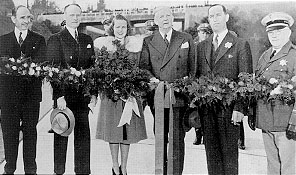| 1902 |
Representative Walter P. Brownlow of Tennessee introduces a bill in the House of Representatives to create a "Bureau of Public Roads" and provide for a system of national, State, and local cooperation in a $20-million program for the permanent improvement of the public highways. The bill resulted from a chance meeting between Brownlow and an acquaintance, OPRI's M. O. Eldridge, on a train trip to Washington, DC. Inspired by the view outside the train window, they began discussing the deplorable condition of the Nation's roads. When Brownlow asked Eldridge to draft a bill based on New Jersey's State-aid law, Eldridge did so with the approval of Director Martin Dodge. The bill sparks controversy, but is not approved. Eldridge worked behind the scenes to support the bill (at one point sending out a million copies of Brownlow's floor speech, printed at government expense and mailed under the government frank of supportive congressmen) but when he is found to be the source of the lobbying campaign, he is dismissed from service. He was later reinstated at lower pay and loss of his rank as second in command of the OPRI. 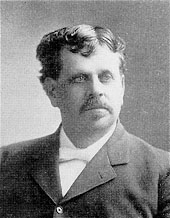
Member of Congress from Tennessee |
| 1992 | FHWA sponsors the first meeting of the Scenic Byways Advisory Committee required by ISTEA. The committee's functions include developing recommendations regarding minimum criteria for use by State and Federal agencies in designating highways as National Scenic Byways and All-American Roads as part of a National Scenic Byways Program. Kevin E. Heanue, Director of the Office of Environment and Planning, serves as Chairman while Scenic Byways Program Manager Eugene Johnson assists the committee in its work. (See April 6, 1994.) |
| 1965 | Administrator Rex Whitton approves changes in the Highway Engineer Training Program as recommended by an Agency study group he appointed to review training. The changes are designed to improve the curriculum's effectiveness and achieve a sizable increase in productive work accomplished by junior engineers. |
| 1968 | Interim EEO policies and procedures go into effect governing prequalification of Federal-aid contractors and subcontractors. |
| 1992 | FHWA sponsors the first meeting of the National Recreational Trails Advisory Committee, authorized by the Symms National Recreational Trails Act of 1991, part of ISTEA. The committee will review the use of funds allocated by the States under the new trails funding program and establish and review criteria for trail-side and trail-head facilities that qualify for funding. The committee will also recommend policy changes that will advance the Symms Act. George Schoener, Chief, Intermodal Division, is FHWA's ex-officio representative, along with Recreational Trails Program Manager Christopher Douwes. |
| 1997 | General Kenneth R. Wykle takes the oath of office as the 14th Federal Highway Administrator. Wykle retired from the Army in 1995 with the rank of Lt. General, serving as Deputy Commander in Chief of the U.S. Transportation Command. Secretary of Transportation Rodney E. Slater notes that Wykle would be the second General to head the agency. The first, General Roy Stone, founded the agency as the U.S. Office of Road Inquiry on October 3, 1893. |
December 3
| 1962 | During AASHO's Annual Meeting in Miami Beach, FL, Administrator Rex Whitton announces the goal of completing 50 percent of the Interstate System by the end of 1964. He reminds State highway officials that they must keep their sights on the 1972 target date for completion of the System. "We need the enthusiastic support of the public for our highway program, support which I am sure can be gained by providing long usable sections of Interstate highways."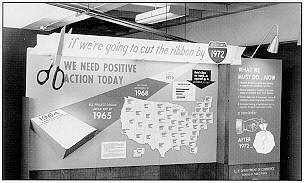
|
| 1968 | At AASHO's Annual Meeting, E. H. "Ted" Holmes, FHWA's Director of Policy Planning, receives the Thomas H. MacDonald Award for outstanding service in highway engineering. |
| 1974 | Thirty-three FHWA hydraulic engineers and representatives of 15 State highway agencies begin a new 2-week course on "Highways in the River Environment," presented by Colorado State University at Fort Collins. It is the first course in river mechanics for highway engineers. |
December 4
| 1894 | ORI issues Bulletin No. 1, State Laws Relating to the Management of Roads, Enacted in 1888-91, compiled by General Roy Stone. He reports that 14 States have passed road laws "more or less radical in their character," but they are so recent that no record of results is available. "In New Jersey, however, the new laws date from 1888 to 1892, and have proved so satisfactory in practice that no effort to amend them was made in 1893." The other 13 States covered are California, Indiana, Massachusetts, Michigan, Missouri, New Hampshire, New York, North Dakota, Oregon, Tennessee, Vermont, Washington, and Wisconsin. |
| 1954 | BPR's L. E. Knight and Paul Potts join C. F. Hotler of the State Highway Department of Indiana to perform the first road roughness test on the Indiana Test Road along U.S. 31 north of Columbus. The resulting report shows roughness in units per mile for each half-mile, for any remaining lesser portion of each test section, and for each lane. The road test was required by State law, but the test pavements were constructed as part of regularly programmed Federal-aid projects. |
| 1970 | Regional Administrator Fred B. Farrell represents FHWA at a ceremony marking the opening of the last segment of the West Leg of the Dan Ryan Expressway in Chicago, IL. Following remarks, U.S. Representative Edward Derwinski, Cook County officials, and Farrell get into their cars and drive through a paper barrier, officially opening the expressway. (See March 1, 1988.)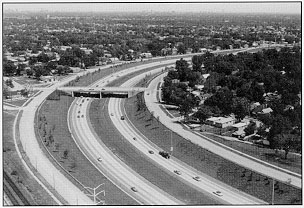
|
| 1971 | At the Fontainebleau Hotel in Miami Beach, FL, to address AASHO's Annual Meeting, Deputy Administrator R. R. Bartelsmeyer begins a speech on "Highway Transportation in a Changing World" by quoting Alfred Lord Tennyson: "The old order changeth, yielding place to the new." Discussing drastic changes in the highway program, he says, "And we do not decry this change. While its effects often are temporarily painful, and difficult to adjust to, it is as necessary as it is inevitable. For change prevents atrophy and stagnation, and it brings in its wake new ideas, new philosophies, new approaches." |
| 1988 | During AASHTO's Annual Meeting, Administrator Robert Farris speaks on "The Nation's Highways: Somewhere Over the Rainbow." He lists four dreams or goals: Cut highway deaths in half, lower travel costs by 25 percent, improve operating efficiency by at least 30 percent, and provide a modern highway to every community of 5,000 or more.
"We've spent a good deal of time trying to identify cost figures and not dreaming some dreams." |
December 6
| 1909 | J. E. Pennybacker, Jr., OPR's Chief of Road Management, addresses the Southern Commercial Congress in Washington, DC, on "The Road Situation in the South." |
| 1923 | President Calvin Coolidge addresses the building of good roads in a message to Congress. |
| 1974 | Administrator Norbert Tiemann and UMTA Administrator Frank C. Herringer sign an agreement providing for an interagency program to meet evolving training needs in urban transportation. The program is designed to develop programs tailored to changing and expanding roles in the transportation field. During the first phase of the new program, needed training will be identified for transportation professionals who are responsible for those phases of systems planning and development that encompass transit as well as auto and truck transportation. The second phase provides for developing priority training and education programs to meet those needs.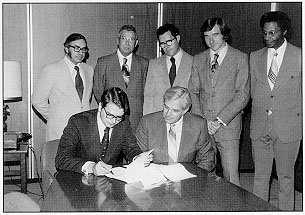
|
December 7
| 1915 | OPR completes construction of bituminous experimental roads on the grounds of the Department of Agriculture. Construction involves two wing drives leading from the sheet-asphalt pavement in front of the main building to the sheet-asphalt plaza in the rear. The experiments were designed to study the behavior of cold-application tars and asphaltic oils of the types suitable for surface treating water-bound and penetration macadams. The roads chosen for the experiment were 16 feet wide and had been resurfaced with limestone macadam in the fall of 1911. In June 1912, they were treated with a molasses-lime mixture, but the treatment was followed by 10 days of heavy rain, during which the mixture was entirely washed off and the surface soon became dusty. Although limited to delivery wagons, carriages, and automobiles, the surface had worn perceptibly by the time the bituminous experiments began. |
December 8
| 1921 | In Omaha, NE, during a speech to AASHO's Annual Meeting, W. K. Hatt, Director of the Advisory Board on Highway Research, begins, "Above the entrance door to the office of the chief of the U.S. Bureau of Public Roads is the saying of the eminent scientist [Thomas] Huxley: Science is nothing but trained and organized common sense." |
| 1964 | Administrator Rex Whitton addresses AASHO's 50th Annual Meeting on "Full Partners: Federal-State Cooperation in the Federal-Aid Highway Program." In his conclusion, Whitton says, "I view the Bureau of Public Roads and the States as partners, neither one greater nor lesser than the other. Each partner has rights and responsibilities, but these cannot be so precisely and rigidly defined as to avoid altogether some questions about the location of the boundary lines. Through the years such questions have almost always been resolved in an informal and friendly way. They still are. I hope they always will be." |
| 1918 | Logan Page dies of a heart attack in Chicago, IL, after becoming ill during a meeting of AASHO's executive committee. During the Joint Highway Congress of AASHO and the Highway Industries Association (December 11-12), Page was to have delivered a talk on "Highway Control by the Federal Government Under War Conditions." An AASHO tribute states, "He more than any other man, has stood for scientific road construction, for education and the use of educated and experienced engineers for carrying out road work."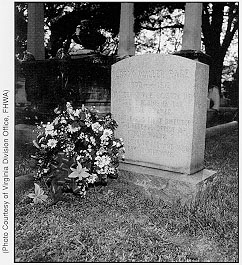
|
| 1991 | Federal-Aid Policy Guide Transmittal No. 1 is issued, transmitting the new guide, which replaces the Federal-Aid Highway Program Manual (FHPM). The new guide includes all the regulatory material in the FHPM and current and valid nonregulatory material. An electronic version of the new guide was posted recently on the FHWA Electronic Bulletin Board System. |
| 1993 | Administrator Rodney Slater, in a heavily attended ceremony at Union Station in Washington, DC, unveils FHWA's recommendations for the National Highway System. "This is perhaps the most important event I will have the opportunity to participate in as your Federal Highway Administrator," he tells the crowd, "because the National Highway System is going to be the backbone of our national transportation network in the 21st century." Secretary Federico Pea announces an initiative to develop an intermodal National Transportation System to guide planning and investments in America's transportation network.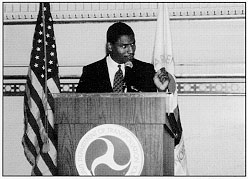
|
December 10
| 1905 | Work, begun September 27, is completed on a limestone macadam object lesson road in Macon, MO. The road is 3,700 feet long, 14 feet wide, and 8 inches deep. It cost $3,229.16, of which $1,478.39 was for 2,217 tons of stone at 66 2/3 cents per ton. The cost of labor was $1.50 per day and of teams, $3. |
| 1976 | Administrator Norbert Tiemann releases A Statement of National Highway Transportation Policy, which discusses the role of the Federal Government in meeting America's future transportation needs. The policy reflects seven principles: individual mobility and accessibility; intergovernmental cooperation and maximum flexibility; continuing economic development and prosperity; greater safety; increased energy efficiency; protection, preservation, and enhancement of the human environment, including natural and cultural resources; and affirmative action to ensure opportunities and benefits of Federal-aid are distributed equitably. |
December 11
| 1912 | OPR's M. O. Eldridge and Paul D. Sargent present an illustrated lecture on the "Roads of the World" at 8 p.m., opening day of the Indiana Better Roads Convention at the German House in Indianapolis. On December 13, Sargent reads Director Logan Page's speech on why every State should have a highway agency and a State-aid plan.
"There are two things that make against roads: water and politics." |
| 1942 | Senior Structural Engineer Harry P. Hart completes a 6-day investigation of the Cali-Buenaventura Road in Colombia, made at the request of the Rubber Reserve Company and representatives of the Colombian government. The goal is to suggest ways of accelerating completion of the unfinished portion. He recommends completing the survey expeditiously; increasing the number of workmen; using small hand-operated machines, such as hand-winches and rock-pans; and completing missing bridges on the Buenaventura end because the lack of communication is hampering the work. |
| 1914 | Twenty highway officials meeting in Washington, DC's Raleigh Hotel form AASHO. Henry G. Shirley, then of Maryland, is elected the first President (1914-1916). Dr. Joseph Hyde Pratt of North Carolina serves as Secretary until December 1921. Director Logan Page, P. St. J. Wilson, and J. E. Pennybacker, Jr., represent OPR. At 2 o'clock, the highway officials are received by President Woodrow Wilson and pose for a photograph in front of the executive office of the White House.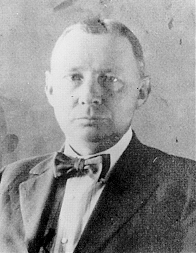
Assistant Director Office of Public Roads |
| 1959 | While on loan to the United Nations to study Egypt's highways, BPR's H. A. Radzikowski is evaluating how construction of the Aswan Dam will affect highway requirements. Today, he interviews General Ibrahim El-Habbal, General Manager of the Kima Fertilizer Plant, and Dr. Hassen Zaky, President of the Aswan High Dam Department. |
December 13
| 1913 | In Boston, MA, Director Logan Page addresses the Civil Service Reform League on "The Merit System in Road Management." His conclusion notes, "I hope this distinguished body will actively join in the good roads movement, not for the purpose of urging larger expenditures, not for the purpose of urging national aid, not for the purpose of developing better methods of construction and maintenance, but for the distinct purpose of seeing that this great public trust is administered for the benefit of the public and as an example of civic righteousness and good management."
"We must consider the public road system of the United States as the only one of the great systems of transportation which is owned and controlled by the public, and in which every tax payer, rich or poor, is a share holder." |
| 1934 | At 2:30 this afternoon, President Franklin Roosevelt convenes a meeting with Interior Secretary Harold Ickes, Relief Administrator Harry Hopkins, Treasury Secretary Henry Morgenthau, Admiral Christian Peoples, and Chief Thomas MacDonald to discuss a proposed transcontinental highway. According to Ickes' diary: "At intervals during the last year I have suggested the possibility of such a highway to the President. He has always been rather taken by the idea, but it has now really struck his imagination and he is giving very serious thought to it. Recently at one of our conferences to consider a program of public works for next year, the President outlined a route for a transcontinental highway from east to west and routes for two or three north and south highways. The meeting today was to consider these routes as outlined on a map of the United States and to consider costs, etc." |
| 1968 | Secretary Alan Boyd announces allocation of 1,472.5 miles of the 1,500 miles added to the Interstate System by the Federal-Aid Highway Act of 1968. The mileage, he says, "will lend more flexibility to the entire system to permit it to meet the tremendous changes in population and development that have occurred since the original 41,000 mile network was charted." The longest sections added are in California (102.5 miles from San Diego to Colton) and Texas (125 miles from Amarillo to Lubbock). The shortest addition is in Iowa (the 0.5-mile Iowa portion of the Sioux City-South Sioux City spur). |
December 14
| 1916 | The schedule for the First International Road Congress at Worcester, MA, is disrupted when a heavy snowstorm interferes with railroad schedules. Director Logan Page, scheduled to speak today on "What the United States is Doing for the Good Roads Movement," did not arrive in time and, instead, will speak on December 15. |
| 1961 | BPR meets with the American Association of Motor Vehicle Administrators, the American Bar Association, the International Association of Chiefs of Police, and the Traffic Institute of Northwestern University to formulate policy for a National Register of Revoked Operators' Licenses. |
| 1967 | Under Federal standards announced by Administrator Lowell Bridwell today, all passenger cars are to be equipped with side marker lamps or side reflex reflectors after December 31, 1968, and side reflectors and side marker lamps after December 31, 1969. |
| 1973 | Addressing the Council of State Governments in New Orleans, LA, Administrator Norbert Tiemann warns that the national energy crisis could critically curtail the Federal-State highway program. "Commuters must realize it is their patriotic duty to use carpools or mass transit . . . and housewives can make a contribution by forming shopping carpools."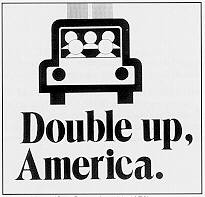
|
| 1924 | In Washington, DC, Secretary of Commerce Herbert Hoover convenes the National Conference on Street and Highway Safety, the first national effort to minimize injuries and loss of life from traffic accidents--22,600 deaths in 1923 and 678,000 personal injuries, representing an economic loss of $600 million. Over 900 representatives of municipal and State police departments, automobile, educational, and civic associations participate. Chief Thomas MacDonald, Herbert Fairbank, A. T. Goldbeck, and E. W. James represent BPR.
"It is fitting and proper that the public officials, the transportation interests, the business interests, the motorists, and those engaged in the business of alleviating suffering should gather together to assist in straightening out the tangle." |
| 1967 | The U.S. 35 Silver Bridge between Point Pleasant, WV, and Gallipolis, OH, collapses at approximately 5 p.m., killing 46 people and injuring 9 when 31 of the 37 vehicles on the bridge fall into the Ohio River or onto the Ohio shore. The collapse, the first major collapse since the Tacoma Narrows Bridge collapsed on November 7, 1940, prompts national concern about bridge conditions and leads to the establishment of the National Bridge Inspection Standards under the Federal-Aid Highway Act of 1968 and the Special Bridge Replacement Program under the Federal-Aid Highway Act of 1970.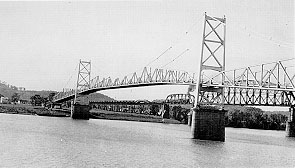 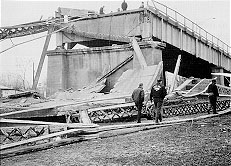
|
| 1969 | The Silver Memorial Bridge opens at Henderson, WV, replacing the Silver Bridge, which collapsed 2 years ago to the day. Administrator Frank Turner comments on efforts to ensure the lessons learned prevent future tragedies: "Involved are complex secrets of the physical sciences not yet completely understood and thus not readily detectable. But within your government, dedicated men and women are seeking the answers to these and many other problems . . . . When we build upon tragedy . . . and find new solutions to increase safety for others, we then can perhaps find small consolation that such a loss has not been in vain. It is really this effort which we dedicate here today." |
| 1988 | At a press conference sponsored by The Road Information Program, former Administrators Ray Barnhart, John Hassell, Norbert Tiemann, and Frank Turner join in denouncing a proposed gasoline tax increase for deficit cutting. Hassell says the plan, if adopted, "would only exacerbate the dilemma facing our nation's surface transportation system." Barnhart says, "It is blatantly discriminatory to single-out motorists from the entire population to bear the brunt of deficit reduction." |
December 16
| 1965 | The Second National Conference on Highways and Urban Development, which began December 12, concludes. Although titled "Highways and Urban Development," the conference is generally known as the Williamsburg Conference after its site in Virginia. BPR's E. H. "Ted" Holmes served as General Chairman.
"What too often is overlooked is that the plans, the planners and the builders of today will be judged, not so much by our contemporaries as by the generation or generations to come, against the background not of our environment but of theirs." |
| 1968 | In the FAA Building, Deputy Federal Highway Administrator John Jamieson opens a week-long hearing on FHWA's proposed regulations covering public hearings and location and design approval for Federal-aid highway projects. FHWA received over 200 requests for the opportunity to be heard. The first witness is Secretary of Agriculture Orville Freeman, who is "heartily in favor of the concept of the two-step hearing and appeals procedure for the location and design" of projects. |
December 17
| 1911 | In a maintenance experiment, OPR assumes responsibility for 8 miles of earth roads in Virginia's Arlington and Jefferson road districts. OPR employs a patrolman to furnish a horse, cart, and small tools. He is supplied with a road drag built of plank and required to drag the road whenever it is in suitable condition for dragging, usually after each rain. The patrolman will be paid $60 per month and $1 a day extra whenever he uses two horses to drag the road. |
| 1915 | E. W. James, OPRRE's Chief of Maintenance, presents a talk on "Road Maintenance and its Significance," to the 7th Annual Convention of the Southern Commercial Congress, Charleston, SC. He states that the attitude of local officials toward maintenance "is one of indifference . . . accompanied by inefficiency, lack of skill and knowledge, poor management, and a strong infusion of the pettiest type of local politics." |
| 1971 | Deputy Administrator Ralph Bartelsmeyer and Associate Administrator for Planning E. H. "Ted" Holmes head an FHWA team viewing a new exclusive bus lane on I-495 between the New Jersey Turnpike and the Lincoln Tunnel. FHWA had entered into a $500,000 contract with the Tri-State Transportation Commission to implement the bus lane, which is opened the next day. |
| 1991 | President George Bush signs the Intermodal Surface Transportation Efficiency Act, the most significant restructuring of surface transportation programs since 1956. Known as ISTEA ("ICE TEA"), the act authorizes $121 billion for Federal-aid highways, $1.6 billion for safety, and $31.5 billion for transit, but through its statewide and metropolitan planning requirements, gives unprecedented flexibility to State and local officials to develop the best mix of projects, whatever the mode. While eliminating the Federal-aid systems, ISTEA broadens eligibility to cover all public roads except local roads and rural minor collectors, authorizes designation of the National Highway System, stresses choices that will help attain National Ambient Air Quality Standards, funds a National Scenic Byways Program, and renews emphasis on alternatives such as bicycling and walking.
"It's summed up by three words--jobs, jobs, jobs." 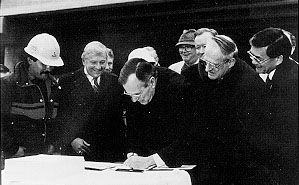
|
| 1999 | Secretary of Transportation Rodney E. Slater joins Deputy Administrator Gloria J. Jeff and Executive Director Anthony R. Kane to launch an on-line travel itinerary called "We Shall Overcome-Historic Places of the Civil Rights Movement." The National Register of Historic Places itinerary features easy-to-read stories about 41 historic sites in 21 States. Director Robert Stanton of the National Park Service and Mayor-elect Anthony Williams of the District of Columbia join Slater, Jeff, and FHWA's Ginny Finch and James Shrouds in the ceremony. |
| 2000 | Timothy R. Penney becomes FHWA's first Native American Program Coordinator. A civil engineer and member of the Red Cliff Band of Lake Superior Chippewa, Penney has been with FHWA for 12 years. He will be FHWA's liaison with Tribal governments and State transportation departments, working with individuals and groups on transportation-related Tribal issues and legislation. |
| 1965 | "A terrible mistake has been made in cities," landscape architect Lawrence Halprin tells The Los Angeles Times. The week before, he and other members of a board appointed by Administrator Rex Whitton to draft guidelines for design and location of urban expressways, had met with Whitton. Halprin says Whitton understands that, "It wasn't realized that as freeways come to cities, they have to not only move people but . . . do this in a way that is not going to destroy the cities." (See May 1, 1968.) |
| 1972 | Secretary of Transportation John Volpe says FHWA will require installation of crash cushions on new Federal-aid freeways, high-speed roads, and high-volume roadways at locations that cannot be designed to eliminate roadside hazards. The devices can help reduce the toll--4,500 lives a year--from crashes with fixed objects. |
| 1987 | The 33.8-mile "Missing Link" of I-95, from PGA Boulevard in North Palm Beach to Fort Pierce, FL, opens, completing all of I-95 with the exception of a planned connection between the New Jersey and Pennsylvania Turnpikes. |
| 1991 | Amid numbing cold, officials gather for the opening of I-476--best known as the Blue Route--in Bucks County, PA. The opening ceremony lasts only 30 minutes because, according to The Philadelphia Inquirer, "No one wanted to see the specially designed, 50-foot-long red, white and blue ribbon whipped away by the wind before [Governor Robert] Casey could cut it." The Inquirer calls the Blue Route "the most costly, most bitterly opposed highway in Pennsylvania history," but the 21.5-mile, $600-million highway is hailed for its environmental sensitivity and harmony with its surroundings. |
| 1995 | Secretary of Transportation Federico Pea announces plans to reorganize the USDOT by combining ten Modal Administrations into three based on the strategies of consolidation, downsizing, and streamlining. The plan would abolish the FHWA. |
| 1997 | With Secretary of Transportation Rodney E. Slater looking on, Gloria J. Jeff takes the oath of office as Deputy Administrator. As Associate Administrator for Policy, she had taken on the role of Acting Administrator prior to the arrival of Administrator Kenneth R. Wykle. (See December 2, 1997.) Jeff is the third woman, and the first African American, to hold the position of Deputy Administrator. |
| 1912 | In a speech to the Automobile Club of America, President William Howard Taft says, "I admit that the general Government has the power for the purpose of promoting interstate commerce to build National roads. [But] I venture to question the wisdom of opening that method of spending Federal Government money . . . because if you once set out upon a plan of National roads in addition to the plan of National waterways, I do not know how great the expenditure will amount to." |
| 1930 | President Herbert Hoover approves an emergency appropriation of $80 million to be apportioned among the 48 States and Hawaii in the same manner prescribed for regular Federal-aid funds. The funds are loans the States can use to match Federal-aid highway funds. However, the funds may be used only for projects that will actually be completed by September 1, 1931, and the amounts actually expended by the States must be repaid over a period of 5 years. This emergency measure is intended to make up for deficiencies of State revenue and permit increased employment on road work during the early road-building season of 1931. (The loans were changed to grants by the Hayden-Cartwright Act of 1934.)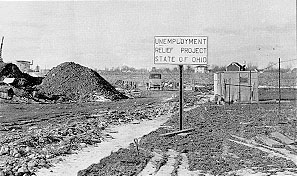
|
| 1944 | President Franklin Roosevelt signs the Federal-Aid Highway Act, approved by Congress after months of wrangling over the shape of the post-war program. The act authorizes $500 million per year for 3 years, including $150 million for a new FAS system to be selected by the State highway agencies in cooperation with county or local road officials and the PRA. The act also authorizes designation of a 40,000-mile National System of Interstate Highways, but without any funds specifically for its construction. |
December 21
| 1918 | Final work on shoulders and ditches is finished on Colorado's first completed Federal-aid project (3.95 miles of the Colorado Springs Highway, part of the Great North and South Highway). The project, which begins at Denver's southern limit, has a 16-foot concrete pavement, with an average thickness of 5 3/4 inches and 4-foot gravel or sand shoulders on each side. Work on the concrete pavement began July 19 and was completed November 5. Total cost is $80,703.10, with a Federal share of $37,198.49 (46.1 percent of the combined cost of construction and engineering). According to the last traffic census, the old road carried 1,200 vehicles a day, considered "very heavy." |
| 1979 | The second, eastbound bore of the I-70/Eisenhower Memorial Tunnel in Colorado opens. (See March 8, 1973.) The contract for the second bore was signed on August 11, 1975; the tunnel was "holed through" on August 17, 1978. The Colorado Department of Highways developed the project in cooperation with FHWA's Division Office. Division Structural Engineer Larry Lutz is FHWA's representative on the project. |
December 22
| 1912 | Director Logan Page transmits OPR Bulletin No. 43, Highway Bridges and Culverts by Charles H. Hoyt (in charge of Bridge Engineering) and William H. Burr (OPR consultant from Columbia University) to Secretary of Agriculture James Wilson. The bulletin, a revision of Bulletin No. 39, issued September 6, 1911, contains an offer to send an engineer whenever possible to confer with local officials, upon request, concerning bridge needs. The offer results in concern that OPR is trying to compete with private engineers. Director Logan Page responds that OPR's intent was not, and never had been, to compete with private engineers. The bridge and culvert work proposed to be taken up by OPR was wholly of an educational and experimental nature and followed the identical policy pursued during the past 12 or 13 years in the construction of object lesson roads, as a result of which many engineers had found employment where none existed before.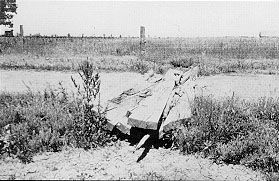
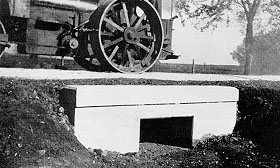
|
| 1955 | Following heavy warm rains that melted snow on the mountains in California, Oregon, and Washington, all BPR employees in the San Francisco and Portland Division Offices (equivalent to Region Offices) are put on alert. In California, BPR is given responsibility for emergency assistance in the repair of all highways and streets, not just those on the Federal-aid systems as usual. Over the next few days, the entire staff of the Division 7 Office and the California District Office set to work, but need help from other offices. In all, 38 engineering teams are organized. |
December 23
| 1982 | Overcoming a 13-day filibuster intended to block a gas-tax increase, the Senate votes 81-5 to approve the Surface Transportation Assistance Act. (Signed January 6, 1983, see entry.) Secretary of Transportation Drew Lewis says, "We think this is a tremendous move forward for transportation." To break the deadlock, several Senators arrived in Washington, DC, today on military aircraft and were taken to the Capitol for the vote in police cars with lights flashing and sirens wailing. |
| 1983 | In an open letter to readers of Better Roads, President Ronald Reagan says, "The rehabilitation of America's highways is essential if we are to maintain the economic recovery that is already under way." He adds, "I can think of no other government program which more effectively illustrates the way in which federal, state and local authorities should work together, in conjunction with private industry, to meet the needs of the public." |
December 24
| 1975 | FHWA releases Your Rights and Benefits as a Highway Relocatee, a brochure intended to help those who are required to relocate because of Federal-aid highway construction.
"It is the policy of the Federal Highway Administration that displaced persons shall receive fair and humane treatment, and shall not suffer unnecessarily as a result of highway programs designed for the benefit of the public as a whole. The Uniform Relocation Act represents the most humane and just legislation on relocation assistance ever enacted by the Federal Government." |
| 1992 | FHWA's Bert Schachnies of the Office of International Programs and Jim Sorenson of the Pavement Division return from Russia after a study tour that began on December 10. In addition to helping develop the basis for cooperation between the two countries on road technology, Schachnies performed a preliminary review of the Russian road construction industry. Sorenson contributed to a World Bank analysis of Russia's road needs, following up on work performed by the French Government. |
December 25
| 1947 | A PRA team in the Philippines to help rehabilitate roads damaged during World War II, shares Christmas Day with their Philippine coworkers, who provide hand-made decorations for the occasion. (See November 14, 1946.) PRA's team includes Frank Turner, Elmer Johnson, Martin Dudderman, and George Williams. The party, which includes an hour-long skit portraying Christmas scenes, helps create a common bond among participants from the two countries. |
| 1893-1996 | Driving to Grandma's for Christmas Dinner gradually gets a lot easier. |
December 26
| 1917 | By Presidential Proclamation, the Federal Government sets up the U.S. Railroad Administration (USRA) and follows up on December 28 by seizing all mainline steam railroads with the intention of operating them during World War I under authority of the Army Appropriation Act of August 29, 1916. Secretary of the Treasury William G. McAdoo is appointed Director General of Railroads. In part, this action is a response to protests by State highway agencies that because of restrictions on rail transport imposed effective November 1, 1917, road work that was dependent on shipment of materials by rail had virtually been halted. (See February 6, 1918.) Under the Transportation Act of 1920, approved February 28, the railroads are returned to private ownership on March 1, 1920. Most activities of the USRA are completed by 1927. (Today's FRA is an unrelated Agency created along with the USDOT on April 1, 1967.) |
December 27
| 1993 | Air quality conformity regulations under the Clean Air Act Amendments of 1990 go into effect today, having been approved by EPA Administrator Carol M. Browner on November 15 after an extensive public involvement process, including review of over 300 written comments. This final rule establishes the process by which FHWA, FTA, and metropolitan planning organizations determine that transportation plans, programs, and projects conform with State or Federal air quality implementation plans for eliminating or reducing the severity and number of violations of the national ambient air quality standards and achieving expeditious attainment of such standards. |
| 1999 | In a special issue on "25 Shapers of the Modern Era," U.S. News & World Report includes former Administrator Frank Turner as "The Superhighway Superman." The magazine says of Turner that after working with Congress during passage of the Federal-Aid Highway Act of 1956 launching the Interstate era, "the career technocrat and engineer shaped the interstate system into the biggest public-works project in U.S. history-and one of the most controversial." |
December 28
| 1922 | Thousands attend the opening of the three-span concrete arch Swift Island Bridge, built with Federal-aid funds across the Yadkin (Pee Dee) River in North Carolina. In 1926, the bridge must be demolished to accommodate construction of a dam 9 miles downstream. The North Carolina State Highway Commission and BPR appoint an advisory committee to conduct tests on the bridge for the benefit of future bridge designers. The committee's report, approved November 8, 1928, appears in the December 1928 and January 1929 issues of Public Roads. In addition, BPR's Office of Motion Pictures releases a 20-minute film showing the method of loading, test apparatus in place, measurements being taken, and scenes of the bridge's destruction with explosives in experiments by the War Department.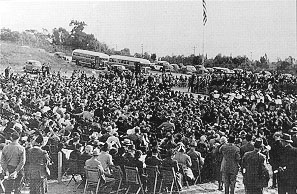
|
| 1961 | 1961 Secretary of Commerce Luther Hodges, Administrator Rex Whitton, NPS Director Conrad Wirth, and State and local officials participate in a ceremony opening the 5,900-foot Woodrow Wilson Memorial Bridge, which will carry Capital Beltway traffic across the Potomac River. Mrs. Woodrow Wilson, widow of the President, was to have unveiled a plaque in the memory of her husband, but she is gravely ill. The bridge, which spans three jurisdictions (Maryland, Virginia, and the District of Columbia), was authorized when President Dwight D. Eisenhower approved House Bill 83-704 on August 30, 1954. In 1958, BPR began construction, which involved 13 contracts. The total cost of the bridge was $14 million. Only short sections of the beltway on either side of the bridge are open, but traffic on the bridge quickly reaches 18,000 vehicles per day.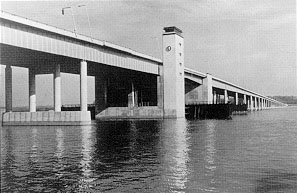
"There is more to a fine bridge than dollars and steel and concrete. There is beauty." |
December 29
| 1912 | In Washington, DC, Director Logan Page speaks on "Utilization of Motor Truck Trains in the Maintenance of Trunk Highways" at the Annual Meeting of the American Association for the Advancement of Science. He describes how OPR hired a motor truck designer to design a motor maintenance "truck train" that includes all the apparatus and facilities needed for efficient maintenance of over 100 miles of road surface by a repair gang of eight men. The theory is based on the thought that "we might 'cure the bite with the hair of the dog.'" |
| 1981 | The Federal-Aid Highway Act redefines Interstate System "construction" to mean providing a minimum level of acceptable service, and adds a fourth R, covering "reconstruction," to I-3R (resurfacing, restoring, and rebuilding). |
December 30
| 1940 | Governor Culbert Olson dedicates California's first freeway, the Arroyo Seco Parkway (renamed the Pasadena Freeway in 1954), built with funding from the Works Progress Administration, the Public Works Administration, and over $500,000 from the PRA, as well as State and local agencies. "It is proper and timely," he says, "for us to pause a few moments to ceremonialize and celebrate an achievement so extraordinary as the completion of this, the Arroyo Seco Parkway . . . . Now that we have it, and it all looks so rather simple, so obviously necessary, so wholly practical, some will ask, 'What is there so wonderful, or so bold about it?' Oh yes--but it takes courage to do a thing the FIRST time, no matter how simple and obvious it may appear AFTER it is done. And this, fellow citizens, is the first Freeway in the West. It is ONLY the first. And THAT is its great promise to the future--the promise of many more freeways to come." The ceremony concludes with the cutting of a "Chain of Roses" by Governor Olson, assisted by the Queen of the 1941 Tournament of Roses, her six Maids of Honor, and State and local officials. The official dedicatory booklet includes thanks to many local, State, and Federal officials, including PRA's Dr. L. I. Hewes and C. H. Sweetzer, who "joined hands to make a dream come true. These men today present to the public this 'Highway of Tomorrow.'" Dr. Hewes contributes remarks to the ceremony on PRA's behalf.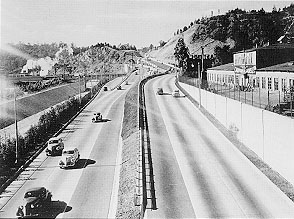
"Thousands of years ago Mother Nature started work on the Arroyo Seco Parkway by carving out a beautiful canyon from the mountains to the sea. It became a natural trail for Man and for centuries and even up to fairly recent times it was used by the Indians as a direct route to the sea . . . So it is not unusual that when men turned to vehicles for their transportation they should attempt to adapt this ancient trailway to their needs."
|
December 31
| 1959 | 1959 After 11 years, the BPR Division Office in Ankara, Turkey, closes, having helped the government expand its network of all-weather roads from 12,140 km to 36,000 km. Division Engineer Fred J. Dixon received a letter from Director General Fevzi Atac, Turkish General Directorate of Highways, expressing appreciation for the Division's contributions to the development of Turkey's highways. In a report, Dixon notes that Turkey now has over 36,000 kilometers of all-weather highways and roads, compared with 12,140 kilometers when BPR began its work. |
| 1970 | The Federal-Aid Highway Act approved today by President Richard Nixon authorizes operation of the National Highway Institute, creates the FAU system and the Special Bridge Replacement Program, and includes measures dealing with environmental considerations, noise standards, and air quality. USDOT is called on to prepare and issue guidelines to ensure consideration of the social, economic, and environmental effects of proposed projects and that final decisions are made in the best overall public interest. The resulting guidelines, known as "Process Guidelines," are issued in September 1972. |
| 1975 | FHWA announces a $6-million Bikeway Demonstration Program, authorized by the Federal-Aid Highway Amendments of 1974, aimed at promoting bicycling as a viable surface transportation alternative. The funds, which may be used to construct bicycle facilities in urban areas, are intended to supplement funds already available for bicycle projects under the regular Federal-aid highway program. Administrator Norbert Tiemann says that, "Such projects, when implemented in large scale, will help to reduce problems of urban congestion, air and noise pollution, and energy consumption." |
Also in December
| 1893 | Colonel Albert A. Pope, a bicycle manufacturer and one of the leaders of the Good Roads Movement since its inception, submits a petition to President Grover Cleveland with 150,000 signatures in support of an independent road department to promote and teach good road building techniques, to display a permanent exhibit on road building methods, and prepare a road exhibit for the World's Columbia Exposition. (Submission of the petition had been delayed, mainly to avoid conflict with consideration of the $10,000 appropriation for ORI, until after the exposition had closed). The petitions were taped together and wound onto two large wooden spools with a rolling mechanism. The entire structure, which measures 67" X 40" X 39", is one of the largest petitions ever submitted to the Federal Government and is now part of the National Archives' collection. In February 1989, the National Archives included the petition in an exhibit called "American Voices: 200 Years of Speaking Out," which ran through February 1990. A review of the exhibit mentioned the good roads petition, noting that, "Despite all that trouble, the petitioners did not get what they wanted."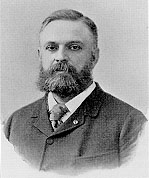
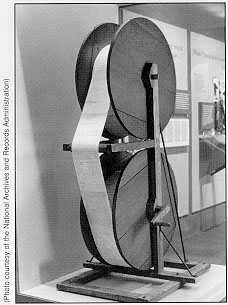
|
|
1900 |
A laboratory for testing of road materials is established under Logan Page as part of the Department of Agriculture's Bureau of Chemistry, with three permanent assistants and one temporary assistant. Any U.S. citizen interested in the construction of public highways can have road materials tested free of charge. By the end of the fiscal year (June 30, 1901), about 100 samples of rock had been received for testing and applications for tests were steadily increasing. Most of the machinery and appliances had to be specially built for the laboratory. They were designed by Page. The laboratory is transferred to the Office of Public Roads upon its creation in 1905, at the same time Page became Director. |
| 1918 | During the first week of December, Director Logan Page is in Denver, CO, for several days of conferences with BPR's western district engineers. He also meets with western State highway officials and representatives of the Forest Service. While in Denver, he addresses the Civic and Commercial Association. He says he is unalterably opposed to permitting motor trucks to use roads not designed to carry the load. "It is unfair, unjust, to expect the taxpayer to pay for roads, then stand by and see them torn to pieces by commercial vehicles operated for the profit of the individual." He then left for AASHO's annual meeting in Chicago, IL. (See December 9, 1918.) |
| 1940 | The Secretary of War appoints a Highway Traffic Advisory Committee composed of Commissioner Thomas MacDonald and the presidents of AASHO, the International Association of Chiefs of Police, and the American Association of Motor Vehicle Administrators. The goal is to promote better use of existing highways and mass transit until highway access to defense-related facilities can be improved. Under local action plans developed with State highway officials, widespread staggered working hours programs reduce traffic peaks by 10 to 15 percent and increase use of buses, streetcars, and carpools. Walking to work is encouraged, but few workers would walk if the one-way distance was more than 2 miles. |
| 1994 | The 40th anniversary issue of American Heritage magazine (December 1994) lists 10 "Agents of Change" during the magazine's lifespan (1954-1994)--people "who changed the way you live ([but] you've never heard of any of them)." Phil Patton's article identifies former Administrator Frank Turner as one of the agents because he "shaped the creation of the largest public-works project in the history of the world, the network of interstate highways that changed the country subtly as much as the transcontinental railroad did overtly." Today, Patton points out, "the interstates' benefits are so taken for granted as to be beneath the level of consciousness. And there is testimony to their power in the contemporary metaphor for the latest infrastructure dream: information superhighway." by the Federal-Aid Highway Amendments of 1974, aimed at promoting bicycling as a viable surface transportation alternative. The funds, which may be used to construct bicycle facilities in urban areas, are intended to supplement funds already available for bicycle projects under the regular Federal-aid highway program. Administrator Norbert Tiemann says that, "Such projects, when implemented in large scale, will help to reduce problems of urban congestion, air and noise pollution, and energy consumption." |


